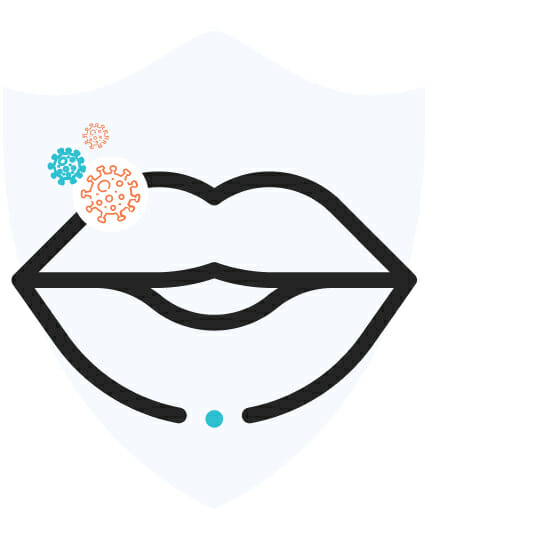
The 10-Test Panel is a comprehensive STD testing package that tests for the most common bacterial and viral STDs in the United States. This inclusive STD testing panel has been carefully designed by physicians to provide you with complete peace of mind.
If you are concerned about recent exposure, we recommend adding the HIV RNA Early Detection Test. The HIV RNA Early Detection Test can detect an HIV infection as early as 6 days after exposure and is conclusive if taken 9 to 11 days post exposure.
The standard HIV test is a 4th Generation HIV 1 & 2 Antibody/Antigen test that can detect HIV as early as 2-3 weeks after exposure.

Gonorrhea causes infections in the genitals, rectum and throat and is spread by vaginal, anal and oral sex. This STD occurs in both men and women and can be passed from mother to child during childbirth.
Testing method: Blood test, urine test, anal swab, urethral swab, cervical swab, throat swab
Testing time: Under five minutes
Time to results: One to five days
Symptoms: Many men and women are asymptomatic but may complain of bladder or urethral infections. Symptoms of these infections can include painful or burning sensations during urination, frequent urination or urgency when needing to urinate, as well as cloudy or bloody urine. When a rectal infection is present, symptoms include discharge, itching, soreness and bleeding.
When you should get tested after exposure: Within five days to two weeks of exposure and two weeks after treatment.

Chlamydia occurs in both men and women. It can cause long-term damage to the female reproductive system, preventing women from being able to carry a child after infection.
Testing method: Blood test, urine test, throat swab, rectal swab, cervical swab, vaginal swab
Testing time: Under five minutes
Time to results: Two to 10 days
Symptoms: Chlamydia can be asymptomatic for many infected persons. In women, chlamydia might cause vaginal discharge and painful urination. In men symptoms might include discharge from the penis, painful urination, swelling and pain in one or both testicles.
When you should get tested after exposure: Within one to two weeks of exposure with retesting after three months. Pregnant women should re-test within three to four weeks after treatment to ensure that the infection has been successfully eradicated.

Syphilis is a curable, yet serious STD that can lead to a broad range of complications or even death. This infection is transmitted via vaginal, anal and oral sex.
Testing method: Blood or spinal tap
Testing time: Under five minutes for a blood test, approximately 30 minutes for a spinal tap
Time to results: Three to five days
Symptoms: While many people don't experience any symptoms initially, others might experience painless sores, rash, fever, swollen lymph glands, sore throat, hair loss, headaches, weight loss, muscle aches, fatigue and organ failure.
When you should get tested after exposure: Within three weeks of sores appearing and six to twelve months after treatment.

Herpes is transmitted via oral, anal or genital sex with another individual who has herpes sores or lesions. It can also be spread by coming into contact with the saliva of a person with oral herpes or skin-to-skin contact with someone who is experiencing an outbreak. It's important to note that herpes is not always sexually transmitted.
Testing method: Blood test or swab of mucosal sore
Testing time: Under five minutes
Time to results: Two to four days for rapid test, up to 14 days for standard culture
Symptoms: Lesions or small blisters on the mouth, genitals or rectum. Symptoms are only present during an active outbreak and therefore, many individuals don't know they've been infected.
When you should get tested after exposure: One to four months

Human Immunodeficiency virus (HIV) attacks a person's immune system and without aggressive treatment, can result in acquired immunodeficiency syndrome (AIDS). HIV and AIDS are currently incurable but treatments are available to slow the progression of HIV.
Testing method: Blood, saliva, blood nucleic acid
Testing time: Under five minutes
Time to results: Rapid testing can provide results in under 30 minutes, standard tests take one to three days
Symptoms: Flu-like symptoms (chills, fever, aches) often occur two to four weeks after exposure but many individuals don't experience any initial symptoms.
When you should get tested after exposure: 10 to 90 days, depending on testing type

Hepatitis can be transmitted via contact with human fecal matter or genital intercourse with an infected individual. It's also commonly transmitted by those who share injectable drugs.
Testing method: Blood
Testing time: Under five minutes
Time to results: Rapid testing can provide results in 20 to 30 minutes, standard tests take one to three days
Symptoms: Many infected individuals are asymptomatic while others may experience symptoms such as fever, fatigue, appetite loss, nausea, vomiting, abdominal pain, dark urine, pale stool, joint pain and jaundice.
When you should get tested after exposure: Three to six weeks for hepatitis A and B, hepatitis C may take as long as eight to 11 weeks before antibodies are detectable



